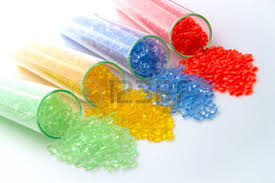Irradiate any part of this new type of resin formulation with UV light, and it solidifies within seconds or minutes. Regardless of its previous shape, the hardening effect spreads outwards until the material is completely solid. The process, called frontal polymerization, can be started anywhere on the novel material, which was developed at the Institute of Applied Synthetic Chemistry at TU Wien, in Vienna, Austria.
"The UV light starts a chemical reaction at a specific point, which temporarily produces a local temperature of up to 200°C," explains Daniel Bomze, a doctoral student on the research team. "The heat spreads and sets off the curing reaction in the adjacent regions of the resin as well. A chemical cascade is initiated, which then keeps running automatically until all of the resin has been cured."
According to the researchers, the technique doesn't affect the classical thermomechanical and electrical properties of the materials. In some case, they claim, it even improved them. They scientists also observed that inorganic fillers displayed no problems for the curing mechanism.
Possible applications for the new synthetic resin and curing process range from repair kits for car bodywork to molded parts for aerospace, to wind turbines and high-tech electronics.
NEW SYNTHETIC RESIN IS CHEAPER AND MORE VERSATILE
Epoxy resins are used in a variety of applications. In the high-tech sector, for example, they insulate electrical components, and stabilize (as chemical anchor bolts) electrical engines and generators, aeronautic and nautical parts. They're also used for repairs, like permanently mending cracks.
Often combined with fiberglass mats or carbon fiber to form high-performance composite materials, epoxy resins can be poured as required in their viscous state. Different curing methods are used depending on the type of resin used. Curing is often conducted in large oven in which the resin is heated to a high temperature,
explains Robert Liska, a professor at the institute.
But bulky objects, like rotor blades for wind turbines, make this curing process difficult, notes Liska. Curing these large items requires heating the entire object, which not only consumes much energy, but also limits the applications to temperature insensitive materials.
Other resin systems consist of two different highly reactive components that need to be mixed in the right proportions before being used and then solidify by themselves within a short period of time. This is not only more time-consuming but is also more difficult to control during processing.
Liska and his team continue to work on developing other epoxy resins that can be selectively cured using UV light in the frontal polymerization process. "These materials are already in use today," he admits. "However, as UV light cannot penetrate particularly deep into the material, this method has so far mainly been used to produce thin decorative coatings or protective coatings."
According to Patrick Knaack, a senior scientist at the institute, the team's epoxy resin formulation "surpasses the materials used to date in terms of both its thermal and mechanical properties." The new resin formulation and frontal polymerization technique also avoids the use of harmful heavy metals. Knaack sees numerous possible applications for the technology, which he says could be used for repair kits because the malleable mass could be manipulated for any length of time before its converted to a solid state using UV light.
Liska adds that it's also possible to cure resins with complicated geometric shapes, for example coatings on electronic components that can't be irradiated from all sides. "Thin inaccessible coatings such as these pose a challenge due to the heat loss. We're able to solve this problem with the new technology."
The team filed two patents for the new synthetic resin formulation, along with a heavy metal-free "starter" for the light-controlled synthetic resin curing process.
BCC Research estimates the global market for components of
epoxy resins to reach $7.5 billion and nearly $10.2 billion in 2016 and 2021, respectively, with a 6.3% CAGR.




